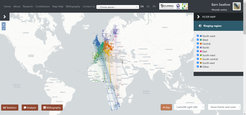First atlas of bird migration across three continents is launched
The Eurasian-African Bird Migration Atlas sets a milestone for more effective implementation of conservation measures
The Max Planck Institute of Animal Behavior’s Movebank system is a key part of an international scientific effort to develop the first atlas of bird migration across three continents. The Eurasian-African Bird Migration Atlas is an online platform where data on the movements in time and space of millions of birds are mapped and analyzed in the Eurasian-African flyway. The interactive tool overlays bird ringing data with Movebank tracking data for 300 species, providing the most complete information available on the migration routes of these species. The new bird atlas is the first part of a broader initiative to develop a global atlas of animal migration. Led by the Convention on the Conservation of Migratory Species of Wild Animals (CMS), the initiative’s goal is to visualize how migratory animals connect continents, countries, sites and habitats.

CMS, an environmental UN treaty, launched the Eurasian-African Bird Migration Atlas on May 26, at the Museum of Migration on the Italian island of Ventotene, as the first part of a broader initiative to develop a global atlas of animal migration.
The interactive Atlas is an online platform where data on the movements in time and space of millions of birds are mapped and analyzed in the Eurasian-African flyway. Researchers from 10 different institutions and data gathered by over 50 different organizations contributed to the Atlas, which was developed by CMS partners, the European Union for Bird Ringing (EURING) and the Max Planck Institute of Animal Behavior.
A major accomplishment of the Eurasian-African Bird Migration Atlas is to have collated, analyzed, and synthesized bird ringing data collected over more than 100 years on 300 species.
In addition, for over 100 of these species, the online mapping tool overlays movement patterns identified through bird ringing with tracks obtained through satellite transmitters, GPS-GSM tags or geo-locators. Together, they provide the most complete information available on the migration routes of these species.
An important visualization tool for more effective implementation of conservation measures
For CMS, whose main goal is to conserve migratory species throughout their migratory range and migration itself as a biological phenomenon, a detailed understanding of the different migratory systems and patterns across the different groups of migratory species is important to design and implement conservation strategies and actions.
The new Atlas offers new insights into migration patterns at the species and population levels and into human-related issues affecting them across their migratory paths.
CMS Executive Secretary Amy Fraenkel said: “Knowledge of how animals move and migrate over time and space is crucial for improving our understanding and conservation efforts for migratory species. The Atlas will help decision-makers in planning networks of sites managed for conservation purposes.”
The information compiled in the Atlas is expected to offer an important contribution to CMS initiatives on the preservation of ecological connectivity – the unimpeded movement of species and the flow of natural processes that sustain life on Earth – and spatial planning in particular. These relate for example to possible interactions between renewable energy infrastructure and animal migration, with a special emphasis on the risk of collision of migratory birds at wind farms. Maps of seasonal movements across geographical areas can help define strategies to minimize bird mortality risks caused by these infrastructures.
The other main feature of the Atlas: four research modules that provide analyses addressing different aspects of bird migration and relationships between man and birds.
- Two modules, migratory connectivity, and long-term changes in migration patterns due for example to global climate change take a closer look at bird migration patterns, strategies, and adaptations.
- Another research module provides estimates, at the scale of EU territory, of the onset of return migration for many huntable species covered by the Birds Directive. The onset of return migration is critically important information to determine the start of the protection period in the year. The module could help reconcile discrepancies among data at a national level.
- The fourth module focuses on a large-scale and long-term analysis of patterns of intentional killing of birds. It describes the frequency and distribution of intentional killing across the whole Eurasian-African flyways and identifies areas of particularly intense legal or illegal harvesting, both in Europe and Africa.
These results are of direct interest for ongoing activities by CMS and the Bern Convention concerning the illegal killing of birds. Furthermore, this module offers insights about expanding the geographical scope of monitoring the illegal killing of birds, for example, along the East Asian-Australasian flyway.
Finally, the broadened historical and geographical perspective can support similar efforts to address the trapping and killing of animals from other taxonomic groups.
The project was made possible by the support of the Government of Italy, with a pledge to CMS granted in 2017 by the Ministry of the Ecological Transition (formerly Ministry of the Environment, Land and Sea) under the Migratory Species Champion Programme.












